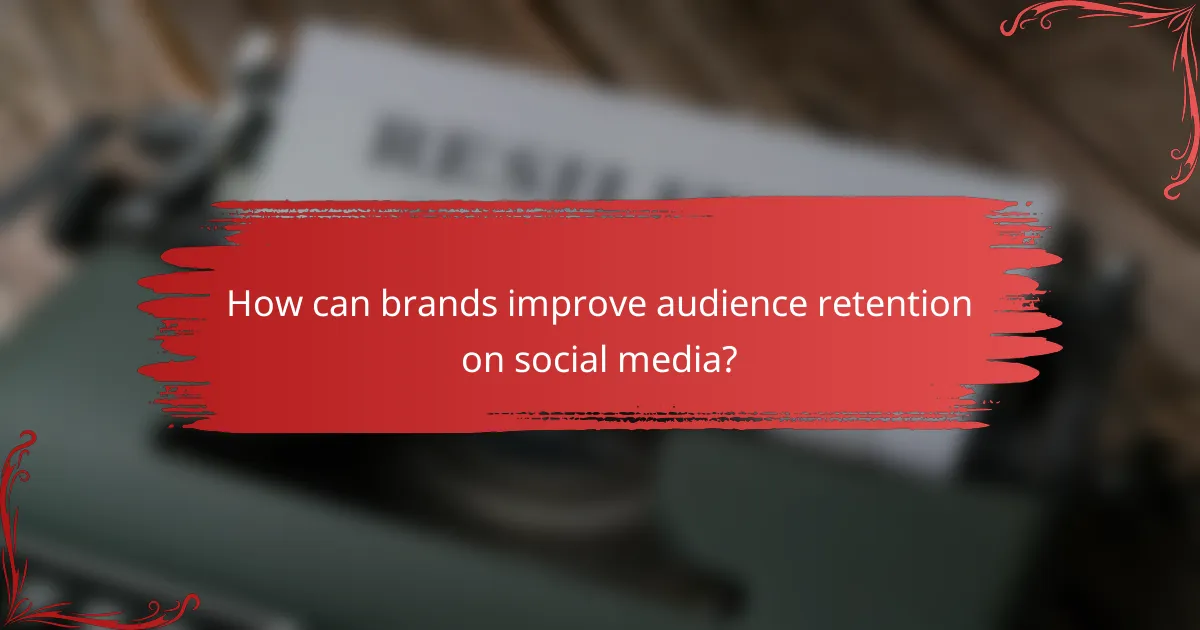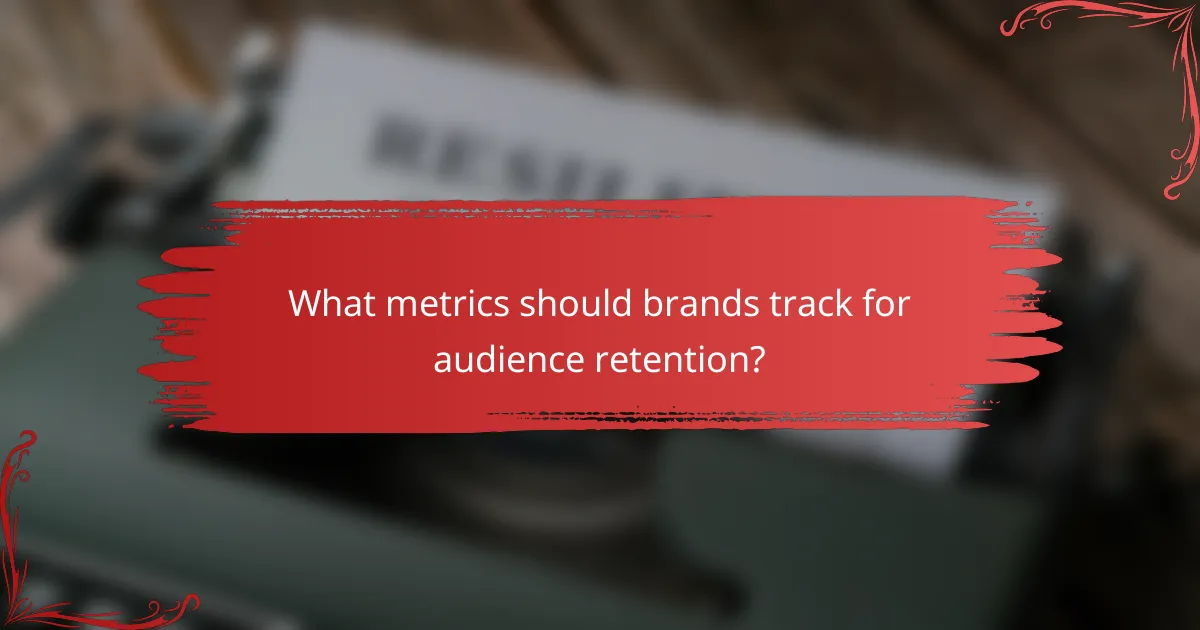In the dynamic landscape of social media, brands must focus on audience retention and engagement by delivering content that resonates with their target demographics. By employing effective tactics such as user-generated content and live video streaming, businesses can foster community and loyalty among their followers. Staying attuned to emerging trends like video content and social commerce is essential for marketers aiming to enhance interaction and retention in an ever-evolving digital environment.

How can brands improve audience retention on social media?
Brands can enhance audience retention on social media by creating engaging and relevant content that resonates with their target audience. This involves understanding audience preferences and consistently delivering value through tailored interactions.
Utilizing personalized content strategies
Personalized content strategies involve customizing posts based on audience demographics, interests, and behaviors. By leveraging data analytics, brands can segment their audience and create targeted messages that speak directly to specific groups.
For example, a fashion brand might showcase different styles based on age groups or local trends, ensuring that each segment feels catered to. This approach can significantly increase engagement rates and foster loyalty.
Implementing interactive features
Incorporating interactive features such as polls, quizzes, and live Q&A sessions can significantly boost audience engagement. These elements encourage participation and make followers feel more connected to the brand.
Brands should consider using stories or posts that prompt users to share their opinions or experiences, which can lead to higher retention. For instance, a food brand might ask followers to vote on their favorite recipes, creating a sense of community and involvement.
Regularly analyzing audience insights
Consistent analysis of audience insights is crucial for understanding what content resonates best. Brands should utilize analytics tools to track engagement metrics, such as likes, shares, and comments, to refine their strategies.
By regularly reviewing this data, brands can identify trends and adjust their content accordingly. For instance, if a particular type of post consistently performs well, it may be beneficial to produce similar content more frequently.
Creating community-focused groups
Establishing community-focused groups on platforms like Facebook or LinkedIn can enhance audience retention by fostering a sense of belonging. These groups allow followers to connect with each other and the brand in a more intimate setting.
Brands should encourage discussions, share exclusive content, and provide value through these groups. For example, a wellness brand might create a support group for fitness enthusiasts, offering tips and motivation, which can lead to increased loyalty and retention.

What engagement tactics are effective for social media?
Effective engagement tactics for social media include leveraging user-generated content, running contests and giveaways, and utilizing live video streaming. These strategies not only enhance audience interaction but also foster a sense of community and loyalty among followers.
Leveraging user-generated content
User-generated content (UGC) involves sharing posts, images, or videos created by your audience. This tactic encourages followers to engage with your brand, as they feel valued when their contributions are showcased.
To implement UGC, create campaigns that invite users to share their experiences with your products or services. For example, you might ask customers to post photos using a specific hashtag, which can then be featured on your official channels. This approach can increase authenticity and trust in your brand.
Running contests and giveaways
Contests and giveaways are effective ways to boost engagement and attract new followers. By offering prizes, you incentivize participation and encourage users to share your content with their networks.
When organizing a contest, clearly outline the rules and entry methods. For instance, you could ask participants to like your post, tag friends, and follow your account. Ensure that the prizes are relevant to your audience to maximize interest and participation.
Utilizing live video streaming
Live video streaming allows brands to connect with their audience in real-time, creating an interactive experience. This format can be used for Q&A sessions, product launches, or behind-the-scenes looks, fostering a more personal connection with viewers.
To effectively utilize live streaming, promote your sessions in advance and encourage viewers to ask questions or comment during the broadcast. This engagement can lead to higher viewer retention and a stronger community feeling among your audience.

What are the latest trends in social media marketing?
The latest trends in social media marketing highlight the increasing importance of video content, social commerce, and ephemeral content. Marketers need to adapt their strategies to engage audiences effectively and leverage these trends for better retention and interaction.
Rise of short-form video content
Short-form video content has surged in popularity, driven by platforms like TikTok and Instagram Reels. These bite-sized videos capture attention quickly, making them ideal for users with limited time and shorter attention spans.
To capitalize on this trend, brands should create engaging, authentic videos that resonate with their target audience. Aim for videos that are around 15 to 60 seconds long to maximize viewer retention and encourage sharing.
Increased focus on social commerce
Social commerce is becoming a key component of social media marketing, allowing users to shop directly through social platforms. This trend simplifies the purchasing process, making it easier for consumers to buy products they discover online.
Brands should integrate shopping features into their social media profiles, such as shoppable posts and live shopping events. Consider offering exclusive discounts or promotions to encourage purchases directly through these channels.
Growth of ephemeral content
Ephemeral content, which disappears after a short period, is gaining traction on platforms like Snapchat and Instagram Stories. This type of content creates a sense of urgency and exclusivity, prompting users to engage quickly.
To effectively use ephemeral content, brands should share behind-the-scenes glimpses, limited-time offers, or interactive polls. Keep the content authentic and relatable to foster a stronger connection with your audience.

How do social media algorithms impact engagement?
Social media algorithms significantly influence engagement by determining which content is shown to users based on their interactions and preferences. These algorithms prioritize posts that foster meaningful interactions, thereby shaping the overall user experience and content visibility.
Prioritization of meaningful interactions
Algorithms prioritize content that encourages genuine interactions, such as comments, shares, and likes. This means posts that spark conversations or resonate emotionally with users are more likely to be featured prominently in feeds.
For example, a post that asks a thought-provoking question or shares a personal story may generate more engagement than a simple promotional post. Brands should focus on creating content that invites dialogue and connection to enhance visibility.
Impact of engagement metrics on visibility
Engagement metrics, such as the number of likes, shares, and comments, directly affect how often a post is shown to users. Higher engagement signals to the algorithm that the content is valuable, leading to increased visibility in users’ feeds.
To maximize visibility, brands should monitor their engagement rates and adjust their strategies accordingly. For instance, experimenting with different content types or posting times can help identify what resonates best with the audience, ultimately driving more engagement and improving algorithmic favorability.

What metrics should brands track for audience retention?
Brands should focus on key metrics such as engagement rates, follower growth, and content performance to effectively monitor audience retention. These metrics provide insights into how well a brand is connecting with its audience and maintaining their interest over time.
Engagement rate analysis
Engagement rate is a critical metric that measures the level of interaction between a brand and its audience. It typically includes likes, comments, shares, and saves, expressed as a percentage of total followers or impressions. A higher engagement rate indicates that the content resonates well with the audience.
To calculate engagement rate, divide the total engagement actions by the total reach or followers, then multiply by 100. For example, if a post receives 200 engagements and reaches 1,000 users, the engagement rate would be 20%. Brands should aim for engagement rates that are above industry averages, which can vary but often range between 1% to 5% for most platforms.
Follower growth trends
Tracking follower growth trends helps brands understand their audience expansion over time. A steady increase in followers indicates successful content strategies and audience retention efforts. Brands should monitor both the rate of new followers and any fluctuations in unfollowing to gauge overall health.
To analyze follower growth, brands can use tools that provide insights into daily, weekly, or monthly growth rates. A healthy growth rate is often considered to be around 2% to 5% monthly. Sudden drops may signal issues with content relevance or audience engagement.
Content performance metrics
Content performance metrics assess how well individual posts or campaigns perform in terms of audience retention. Key indicators include views, shares, and average watch time for video content. These metrics help brands identify which types of content keep their audience engaged and returning for more.
Brands should regularly review content performance to refine their strategies. For instance, if video posts have an average watch time of over 60 seconds, it indicates strong viewer interest. Conversely, content with low engagement should be re-evaluated or adjusted to better meet audience preferences.
